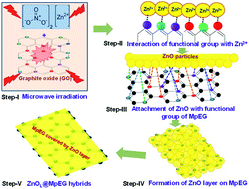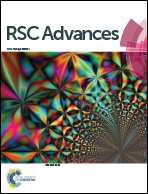Microwave-assisted synthesis and deposition of a thin ZnO layer on microwave-exfoliated graphene: optical and electrochemical evaluations†
Abstract
A rapid and facile microwave-assisted method has been developed for the deposition of a zinc oxide layer (ZnOL) in situ on partially microwave exfoliated graphene (MpEG). The formation of the ZnO layer on microwave partially exfoliated graphene (ZnOL@MpEG) hybrid only requires zinc nitrate and the MpEG sheets are reacted under a low level of microwave irradiation (700 W) for 5 min. The deposited thin ZnOL on the MpEG sheets is uniformly well-dispersed and covers the whole MpEG sheets. The as-prepared ZnOL@MpEG hybrids demonstrate enhanced electrochemical properties as supercapacitors and also show quenching phenomena for photoluminescence. The fluorescence quenching observed for the ZnOL@MpEG hybrids compared to ZnO, indicates photoinduced electron transfer from ZnO to the MpEG layers, which shows recombination of hole and electron charge carriers. The electrochemical measurements exhibit that the ZnOL@MpEG hybrids have a large integral area of the cyclic voltammetry loop, indicating that such hybrids are promising for application in supercapacitors. The material displayed a high specific capacitance of 347 F g−1 at a current density of 5.0 A g−1. A mechanism for the formation of the ZnOL@MpEG hybrids via the microwave method has also been proposed.


 Please wait while we load your content...
Please wait while we load your content...